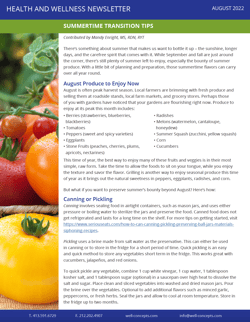SUMMERTIME TRANSITION TIPS
Contributed by Mandy Enright, MS, RDN, RYT
There’s something about summer that makes us want to bottle it up – the sunshine, longer days, and the carefree spirit that comes with it. While September and fall are just around the corner, there’s still plenty of summer left to enjoy, especially the bounty of summer produce. With a little bit of planning and preparation, those summertime flavors can carry over all year round.
August Produce to Enjoy Now
August is often peak harvest season. Local farmers are brimming with fresh produce and selling them at roadside stands, local farm markets, and grocery stores. Perhaps those of you with gardens have noticed that your gardens are flourishing right now. Produce to enjoy at its peak this month includes:
- Berries (strawberries, blueberries, blackberries)
- Tomatoes
- Peppers (sweet and spicy varieties)
- Eggplants
- Stone Fruits (peaches, cherries, plums, apricots, nectarines)
- Radishes
- Melons (watermelon, cantaloupe, honeydew)
- Summer Squash (zucchini, yellow squash)
- Corn
- Cucumbers
This time of year, the best way to enjoy many of these fruits and veggies is in their most simple, raw form. Take the time to allow the foods to sit on your tongue, while you enjoy the texture and savor the flavor. Grilling is another way to enjoy seasonal produce this time of year as it brings out the natural sweetness in peppers, eggplants, radishes, and corn. But what if you want to preserve summer’s bounty beyond August? Here’s how:
Canning or Pickling
Canning involves sealing food in airtight containers, such as mason jars, and uses either pressure or boiling water to sterilize the jars and preserve the food. Canned food does not get refrigerated and lasts for a long time on the shelf. For more tips on getting started, visit https://www.seriouseats.com/how-to-can-canning-pickling-preserving-ball-jars-materials-siphoning-recipes
Pickling uses a brine made from salt water as the preservative. This can either be used in canning or to store in the fridge for a short period of time. Quick pickling is an easy and quick method to store any vegetables short term in the fridge. This works great with cucumbers, jalapeños, and red onions.
To quick pickle any vegetable, combine 1 cup white vinegar, 1 cup water, 1 tablespoon kosher salt, and 1 tablespoon sugar (optional) in a saucepan over high heat to dissolve the salt and sugar. Place clean and sliced vegetables into washed and dried mason jars. Pour the brine over the vegetables. Optional to add additional flavors such as minced garlic, peppercorns, or fresh herbs. Seal the jars and allow to cool at room temperature. Store in the fridge up to two months.
Freezing
The freezer is a fantastic way to enjoy summertime fruits and veggies all year long. Store washed and dried fruits and veggies in freezer-safe bags or containers to enjoy anytime.
- Freeze berries or cut up stone fruit to use in smoothies, sauces, and beverages.
- Slice corn off the cob and freeze the kernels to use for quick side dishes and to add to soups. Save and freeze those cobs – you can add them to soup stocks for flavor.
- Freeze grilled or air-fried eggplant slices for a quick weeknight eggplant parm or veggie lasagna.
- Freeze whole cherry tomatoes to use in sauces and soups.
- Produce with high water content such as watermelon, large tomatoes, or cucumbers won’t freeze well, but you can puree and then freeze. Puree watermelon or cucumber and place the puree in ice cube trays to freeze; add to water to infuse or toss into soups or sauces for added flavor. Freeze tomato puree to make tomato-based sauces or a batch of tomato soup to freeze end enjoy on a cold winter day (see recipe below).
- Freeze fresh herbs in ice cube trays. Pack the herbs into ice cube trays, then top off with water or olive oil and freeze. Toss the herb cubes into sauces to add flavor.
RECIPE CORNER: ROASTED TOMATO SOUP
INGREDIENTS:
- 8 plum, beefsteak, or heirloom tomatoes, quartered
- 1 sweet onion, coarsely chopped
- 4 garlic cloves, peeled
- 1 tablespoon extra-virgin olive oil
- 2 cups vegetable broth
- 1 tablespoon fresh thyme
- 1 teaspoon dried oregano
- ⅛ teaspoon cayenne pepper (optional)
- 1 tablespoon apple cider vinegar
- ½ cup chopped basil leaves
- 1 cup nonfat milk or unsweetened almond or oat milk (optional)
- Salt & Pepper (to taste)
PREPARATION:
1. Toss the tomatoes, onions, and garlic cloves in olive oil. Season with salt & pepper to taste. Roast on a parchment paper lined baking sheet at 425ºF in the oven for 40-50 minutes, until browned.
2. While vegetables are roasting, combine broth, thyme, oregano, cayenne pepper, and apple cider vinegar in a large stock pot. Bring to a boil, then simmer while tomatoes roast.
3. Add roasted vegetables to stock pot and add basil. Stir in milk (if using) and remove from heat. Using an immersion blender, combine till smooth. Alternatively, transfer the mixture to a blender or food processor to blend, working in batches.
4. Transfer the mixture into freezer-safe containers, leaving 1-inch at the top. Allow to cool completely, then freeze. When ready to enjoy, thaw and reheat on stovetop or microwave.
![]() Mandy Enright MS, RDN, RYT, is a Registered Dietitian, Yoga Instructor, and Corporate Wellness Expert, as well as main content contributor for Wellness Concepts. Mandy is a featured presenter, both virtually and onsite near her home in Neptune, NJ.
Mandy Enright MS, RDN, RYT, is a Registered Dietitian, Yoga Instructor, and Corporate Wellness Expert, as well as main content contributor for Wellness Concepts. Mandy is a featured presenter, both virtually and onsite near her home in Neptune, NJ.


